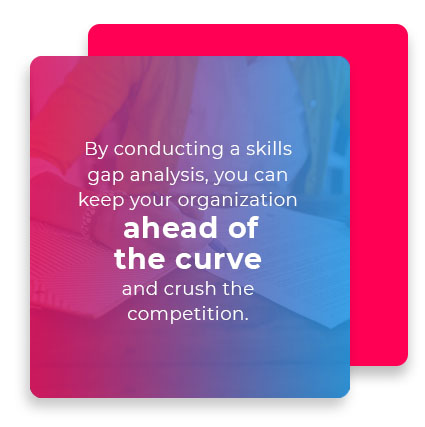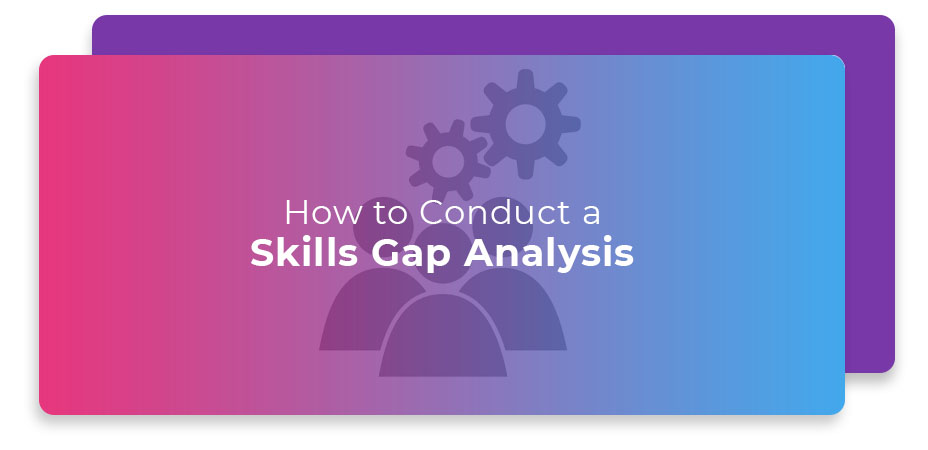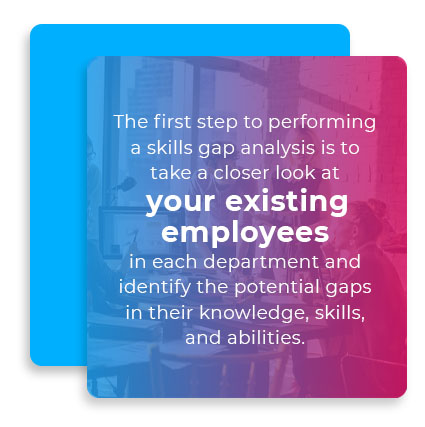Gaps are rarely seen as positive things, no matter what the context. The gaps in your teeth can cause food to get stuck in crevices, leading to tooth decay. Gaps in your diet can contribute to nutrient deficiencies, making you feel slow and sluggish. The skills gap in your workforce is no different in this regard. When your employees lack certain skills and knowledge, inefficiency is bound to creep into your organization.
Having a skilled workforce is key to reaching your organization’s current and future goals. But how do you make sure that your workforce is well-trained and has the critical skills they need? The answer is a skills gap analysis.
What Is a Skills Gap Analysis?
Put simply, a skills gap analysis makes it easier to identify the gaps between an employees’ existing skills and knowledge and the projected skills that the organization needs to reach its goals. When conducted properly, this assessment can provide your organization with the data and knowledge it needs to establish more specific training and hiring practices, which ultimately leads to a more competent, committed and innovative workforce.
Specifically, a skills gap analysis offers the following benefits:
- Provides a complete overview of the entire organization and highlights specific skills the company needs.
- Allows organizations to leverage workforce development software that optimizes their short-term and long-term recruitment strategies.
- Boosts employee productivity and satisfaction by helping them achieve their professional goals and dreams.
- Promotes a culture of learning in which employees are encouraged to seek additional training and credentials.
- Provides organizations with the tools and skills they need to remain competitive within their industry.
How to Conduct a Skills Gap Analysis
It’s difficult to train or hire skilled employees when you don’t know what you’re looking for in the first place. Conducting a skills gap analysis involves three steps: assessing your organization, identifying the gaps, and developing a strategy.
 Step 1: Assess Your Organization
Step 1: Assess Your Organization
The first step to performing a skills gap analysis is to take a closer look at your existing employees in each department and identify the potential gaps in their knowledge, skills, and abilities. This step typically requires gathering and developing a comprehensive skills inventory for each of your employees.
When conducting a skills gap analysis, it’s important to gather data from multiple sources. For instance, you should be: analyzing key performance indicators (KPIs), conducting regular employee performance reviews, using surveys and assessments, and standing on the front lines to assess skill gaps.
While you’re busy gathering data, this is also a good time to think about the future needs and goals of your organization. Here are a few questions to consider:
- Where is the organization headed?
- What’s on the horizon for our industry in the next year? The next five years?
- What skill sets do we currently need? What skill sets will we need in the future?
- How will we develop the strategies we need to stay focused and to reach our goals?
- What factors currently impact our ability to attract and retain valuable employees?
Step 2: Identify the Gaps
The next step is to identify the gap between where your organization’s existing skill set is and where you want it to be in the future. This step involves identifying not only the number of employees the organization will need to reach its goals, but also the skills each individual needs to perform their job effectively.
A good way to start is by listing the various skills (both soft and technical) of each individual. Then, compare their existing skills with the ones that are currently needed in both the short- and long-term. It’s also helpful to perform a team analysis to measure the skill set of your entire department.
Questions to consider at this step may include:
- What new skills does each team need?
- Do our existing employees have the ability to develop these skills, or will we need to hire externally?
- Are employees in a position to maximize their strengths?
- Do we currently have enough supervisors/managers?
- Do our organization’s policies put us in a position to attract the talent we need in the future?
Step 3: Develop a Strategy
Once you’ve completed a thorough skills gap analysis, you can then act on the data by developing a strategy. While the details of your strategy may vary depending on your organization’s needs, there are generally two ways to fill a skills gap: training and hiring.
Training existing employees can be beneficial for several reasons. Providing your staff with opportunities for continued education and training signals that you value their growth and development — a move that could pay off in the long-term. According to a 2020 study from the University of Würzburg in Bavaria, Germany, economists found that, on average, training significantly increases an employee’s loyalty and productivity.
Your internal training and development program could include:
- Providing staff with the training they need to take on a new role within the company.
- Encouraging staff to obtain certificates, such as the Certified Workforce Development Professional (CWDP).
- Setting aside funds to help employees continue their education through vocational school or college.
- Attending events and conferences.

Your recruitment strategy could include:
- Use workforce development software to recruit top talent and grow your talent pool.
- Develop a company culture that sets you apart from the competition and makes your organization more attractive to job candidates.
- Modifying your interview process to make it accessible to a broad range of personalities, including neurodiverse candidates.
Mind the Gap
A skilled workforce can be your organization’s secret weapon to success, but finding and developing the right talent is no easy task. By conducting a skills gap analysis, you can keep your organization ahead of the curve and crush the competition.
Image Credits
Source: Matthew Addington/Death to Stock
Source: Rawpixel.com/Shutterstock
Source: Pavel Stasevich/Shutterstock


 Step 1: Assess Your Organization
Step 1: Assess Your Organization

